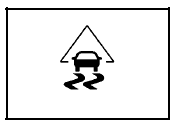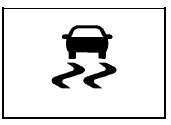Chevrolet Cobalt Owners Manual: Electronic Stability Control (ESC)
The vehicle may have an Electronic Stability Control (ESC) system which combines antilock brake, and traction and stability control systems that help the driver maintain directional control of the vehicle in most driving conditions.
When the vehicle is started and begins to move, the system performs several diagnostic checks to ensure there are no problems. The system may be heard or felt while it is working. This is normal and does not mean there is a problem with the vehicle. The system should initialize before the vehicle reaches 32 km/h (20 mph).
If the system fails to turn on or activate, the ESC/TCS light comes on, and the ESC OFF and/or SERVICE ESC message displays.
For more information, see Driver Information Center (DIC) and Electronic Stability Control (ESC)/Traction Control System (TCS) Indicator/Warning Light.

This light flashes on the
instrument panel cluster
when the ESC system is
on and activated.
ESC activates when the computer senses a discrepancy between the intended path and the direction the vehicle is actually traveling. ESC selectively applies braking pressure at any one of the vehicle's brakes to help steer the vehicle in the intended direction.
When the system activates, an ESC ACTIVE message displays on the Driver Information Center. See DIC Warnings and Messages. This light also flashes on the instrument panel cluster when the ESC system is on and activated. Noise or vibration may be felt in the brake pedal. This is normal. Continue to steer the vehicle in the desired direction.
When the light is on solid and the message(s), SERVICE ESC, ESC OFF, or both display, the system will not assist the driver in maintaining directional control of the vehicle. Adjust your driving accordingly.
See DIC Warnings and Messages.

The Electronic Stability Control (ESC) system is automatically enabled whenever the vehicle is started.
To assist the driver with vehicle directional control, especially in slippery road conditions, always leave the system on. ESC can be turned off if needed.
If the vehicle is in cruise control when the system begins to assist the driver maintain directional control of the vehicle, the ESC/TCS light will flash and the cruise control will automatically disengage. The cruise control can be re-engaged when road conditions allow. See Cruise Control.
The ESC/TCS button is
located on the instrument
panel.
The traction control system can be turned off or back on by pressing the ESC/TCS button. To disable both traction control and ESC, press and hold the button from five to ten seconds.
When the ESC system is turned off, the TRACTION OFF and ESC OFF messages appear, and the ESC/TCS light comes on to warn the driver that both traction control and ESC are disabled.
It is recommended that the system remain on for normal driving conditions, but it may be necessary to turn the system off if the vehicle is stuck in sand, mud, ice or snow, and you want to “rock” your vehicle to attempt to free it. It may also be necessary to turn off the system when driving in extreme off-road conditions where high wheel spin is required. See If Your Vehicle is Stuck in Sand, Mud, Ice, or Snow.
ESC may also turn off automatically if it determines that a problem exists with the system. The ESC OFF and SERVICE ESC messages and the ESC/TCS light comes on to warn the driver that ESC is disabled and requires service. If the problem does not clear after restarting the vehicle, see your dealer/retailer for service. See DIC Warnings and Messages for more information.
Adding non-dealer/non-retailer accessories can affect the vehicle's performance. See Accessories and Modifications for more information.
 Braking in Emergencies
Braking in Emergencies
At some time, nearly every driver gets into a situation
that requires hard braking.
If the vehicle has Electronic Stability Control (ESC)
with Antilock Brake System (ABS), it allows the driver
to ...
 Competitive Driving Mode (SS Models Only)
Competitive Driving Mode (SS Models Only)
The driver can select this optional handling mode by
pressing the ESC/TCS button on the console two times
quickly. COMPETITIVE MODE will be displayed in the
DIC. See DIC Warnings and Messages.
Com ...
See also:
Chevrolet Cobalt Owners Manual. Tire Sidewall Labeling
Useful information about a tire is molded into its
sidewall. The examples below show a typical
passenger vehicle tire and a compact spare tire
sidewall.
Passenger (P-Metric) Tire Example
(A) Tire Size: The tire size is a combination of
letters and numbers used to define a particular
tire's ...
Chevrolet Cobalt Owners Manual
- In Brief
- Seats and Restraint System
- Features and Controls
- Instrument Panel
- Driving Your Vehicle
- Service and Appearance Care
- Maintenance Schedule
- Customer Assistance Information
Chevrolet Cobalt Service Manual
- Air Bags
- Air Conditioning & Heater
- Body & Frame
- Brakes
- Cooling System
- Driveline
- Electrical
- Electronic Stability Controls
- Engine Service
